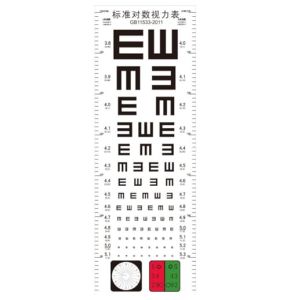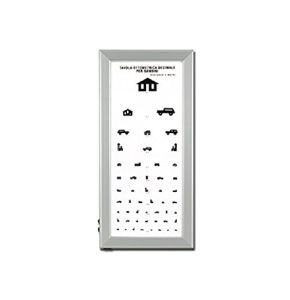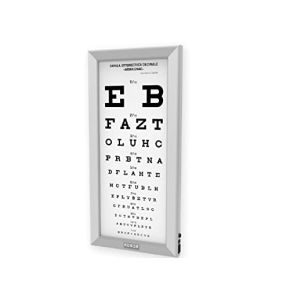Optometric scale
18/11/2024 232
18/11/2024 202
18/11/2024 286
18/11/2024 263
18/11/2024 269
18/11/2024 253
18/11/2024 280
18/11/2024 246
18/11/2024 264
18/11/2024 212
18/11/2024 319
18/11/2024 279
18/11/2024 244
18/11/2024 245
18/11/2024 291
18/11/2024 256
18/11/2024 285
18/11/2024 221
18/11/2024 262
18/11/2024 223
18/11/2024 232
18/11/2024 307
18/11/2024 342
Optometric Scale: An Essential Tool for Ophthalmologists
Discover our "OPTOMETRIC SCALE" booth, specially designed for healthcare professionals who wish to offer the best to their patients and optimize their practice. We offer a selection of essential tools for visual screening. Optometric scales are essential for evaluating vision quality and detecting potential eye problems.
At Placemed, we have gathered an exceptional range of high-quality optometric scales, from traditional Snellen models to advanced LogMAR scales. Each scale, including the Monoyer scale, is designed to meet your specific needs in vision assessment.
Our booth is your ideal source to discover, compare, and purchase the best optometric devices available on the medical market. Elevate your practice to a higher level with products combining precision, reliability, and quality design!
Why is Visual Screening So Important?
Vision is a crucial sense that influences our quality of life. Regular visual screening allows for the detection of eye problems before they worsen. Vision disorders can affect academic performance in children, workplace safety, and even driving.
By using optometric scales, healthcare professionals can quickly and effectively assess their patients' visual acuity. This helps identify needs for optical correction or detect more serious conditions that require specific management.
What is an Optometric Scale and Why is it Fundamental?
An optometric scale is a tool that displays symbols, letters, or images of varying sizes. The patient must identify these elements from a certain distance to assess their visual capability. This tool is fundamental as it provides a standardized method for measuring visual acuity.
Through these scales, professionals can compare results between different patients and monitor an individual's vision over time. It is a key element in the screening and diagnosis of visual disorders.
What Are the Different Types of Optometric Scales?
Snellen Scale
The Snellen scale is the most well-known and widely used. It consists of uppercase letters of decreasing sizes. The patient reads the letters from a standard distance, typically six meters. This scale is simple to use and suitable for most adults.
LogMAR Scale
The LogMAR scale is a more modern version that offers a more precise measurement of visual acuity. It uses letters with regular spacing and a logarithmic progression in size. This allows for a more detailed assessment, especially in clinical studies.
Monoyer Scale
The Monoyer scale is a specific optometric scale developed by Henri Monoyer. It is particularly used in France and some French-speaking countries. This optometric scale features unique characteristics in the arrangement of letters and the scoring method, providing a reliable alternative to the Snellen and LogMAR scales.
Scales for Children
For children who cannot yet read, specific scales are used:
- Lea Scale: It uses simple symbols like an apple, a house, or a square.
- Pigassou Scale: Designed for very young children, it uses familiar and easy-to-recognize images.
These scales allow for the evaluation of children's vision in a fun and age-appropriate manner.
Advantages and Limitations of Each Type
Each type of scale has its own advantages and limitations:
- Snellen Scale: Simple and quick, but less precise for low visual acuities.
- LogMAR Scale: More precise, ideal for detailed monitoring, but requires more time.
- Scales for Children: Adapted to young patients, but less precise than scales for adults.
- Monoyer Scales: Adapted to Francophone standards, offering a reliable method for practitioners in these regions.
The choice of scale depends on the patient and the purpose of the screening.
How to Conduct an Effective Visual Screening?
Optimal Conditions for Testing
To obtain reliable results, it is important to adhere to certain conditions:
- Lighting: The room must be well-lit, without reflections or shadows on the scale.
- Distance: Respect the standard distance between the patient and the scale, typically six meters.
- Positioning: The patient should be comfortably seated, with a straight back, facing the scale.
These conditions ensure an accurate measurement of visual acuity.
Instructions for the Patient
It is essential to provide clear instructions to the patient:
- Explain the test and its procedure.
- Ask to cover one eye without pressing on it.
- Encourage the patient to read the smallest possible symbols or letters.
Good communication facilitates the test and reduces patient stress.
Interpretation of Results
After the test with an optometric scale such as the Monoyer scale, the results must be correctly interpreted:
- Compare the results with established norms.
- Identify differences between the two eyes.
- Note any difficulties or unusual patient behaviors.
This allows determining whether correction or further examination is necessary.
What Are the Technological Innovations in Optometric Scales?
Digital and Interactive Scales
Technological advancements have led to the development of digital scales. These devices offer several advantages:
- Flexibility: Easy change of tests and symbols.
- Precision: Precise control of the size and contrast of images.
- Interaction: Ability to record responses and track patient progress.
These scales modernize visual screening and make it more engaging.
Tablet or Smartphone-Based Tests
Mobile applications now allow visual tests to be conducted on tablets or smartphones. This offers several benefits:
- Portability: Ability to perform tests anywhere.
- Accessibility: Useful for screenings in schools or remote areas.
- Customization: Adaptation of tests to the specific needs of the patient.
However, it is important to properly calibrate the device to ensure the reliability of the results.
Integration of Complementary Tests
New scales can include additional tests:
- Contrast Sensitivity: Assesses the ability to distinguish shades of gray.
- Color Vision: Detects anomalies in color perception.
- Visual Field: Measures the extent of peripheral vision.
These tests provide a comprehensive evaluation of the patient's visual health.
How Do Optometric Scales Adapt to Specific Populations?
Tests for Non-Literate Individuals
For patients who cannot read, scales with symbols or images are used, including adapted versions of the Monoyer scale. This ensures that the test is accessible to everyone, regardless of education level.
Evaluation in Children
Children require a particular approach:
- Use of games to capture their attention.
- Scales with familiar images.
- Short tests to avoid fatigue.
This allows early detection of visual disorders that can affect their development.
Screening in the Elderly
With age, the risk of visual disorders increases. Optometric scales adapted for seniors take into account:
- High contrast for better readability.
- Longer response times.
- Clear and simple instructions.
Regular screening helps maintain a good quality of life in the elderly.
Screening in Schools or Remote Areas
Portable or digital scales facilitate screening in various environments:
- Interventions in schools to screen for disorders in children.
- Tests in rural areas where access to care is limited.
- Use of mobile kits to reach a broader population.
This contributes to better prevention of eye problems within the community.
What Is the Role of an Optometric Scale in Prevention and Diagnosis?
Early Detection of Visual Disorders
Regular screening allows for the detection of disorders such as:
- Myopia: Difficulty seeing objects at a distance.
- Hyperopia: Difficulty seeing objects up close.
- Astigmatism: Blurry vision due to an irregular curvature of the cornea.
Early detection allows for prompt correction, preventing the worsening of the disorder.
Referral to Specialists
If screening reveals a problem, the patient can be referred to:
- An ophthalmologist for a comprehensive examination.
- An optician for optical correction.
- An orthoptist for visual exercises.
This ensures appropriate and effective management.
Why Choose Your Optometric Scale from Placemed?
At Placemed, you benefit from:
- Quality: Certified products meeting professional standards.
- Variety: A wide range of scales for all needs.
- Competitive Prices: Attractive rates for excellent value for money.
- Customer Service: A dedicated team to advise you and answer your questions.
By choosing Placemed, you choose reliability and satisfaction. We are committed to providing you with high-quality optometric devices that meet your professional requirements.
Conclusion
Optometric scales are indispensable tools for the screening and monitoring of visual health. They allow for a quick and accurate assessment of visual acuity, contributing to the early detection of eye disorders. With technological innovations, these tools are becoming increasingly accessible and adapted to the specific needs of patients.
At Placemed, we are committed to providing you with the best products for your professional practice. Explore our "OPTOMETRIC SCALE" selection and choose quality for your patients. Clear vision is essential for a fulfilling life, and together, we can help preserve it.
 Francais
Francais 
























